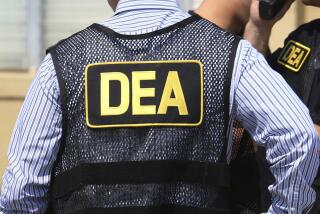Drug Testing vs. Employee Privacy: Long Struggle for Fairness Lies Ahead
Within the past year officials from both the public and private sectors have been trying to hammer out sensible policies on a personnel matter that could affect 90 million Americans: Whether to test their employees for the presence of drugs.
This dilemma has produced two sharply competing positions. Employers say that they face rising levels of accidents and impaired performance from millions of employees--and executives--whose on-the-job behavior is affected by drug and alcohol abuse. To curb such losses, and to avoid possible increased legal damages for failing to take available countermeasures, many companies are instituting broad drug screening programs for both job applicants and current employees. Recently the U.S. Supreme Court cleared the way for federal authorities to begin a drug and alcohol-use testing program for the nation’s railroad workers.
On the other side are many unions, civil- liberties groups and employees who are troubled that taking and “passing” various breath, blood or urine tests may become a requirement for getting and keeping a job. Critics not only attack the scientific validity of the tests but, more fundamentally, note that these tests measure the lingering presence of substances that employees usually have consumed in their private lives, not on the job.
Critics also fear that testing offers some unscrupulous employers a new weapon to use against employee whistle-blowers, union activists and others “troublesome” to management.
Twenty years ago, employers, especially private ones, did have virtually complete discretion under American law and social standards to demand any information that they wanted about an applicant’s or employee’s personal life. Employers could also use almost any information-gathering technique--polygraphs, personality tests, arrest records, credit reports, political blacklists, etc.
Then, in the 1970s, fundamental changes in American social values and expanded notions of employee rights ended the days of employer discretion. Legislation, common-law judicial doctrines, and enlightened employer policies limited inquiries and record-keeping to job-relevant matters, and either forbade or regulated many “intrusive” information collection techniques.
Now we are entering a major reconsideration of this employee-privacy framework. A three-year study that my colleague, Michael A. Baker, and I are conducting for the U.S. Bureau of Justice Statistics, found that a large majority of leading companies with employee-privacy codes now believe that they must turn to new techniques to deal with increasingly serious substance abuse and theft problems.
The Drug Enforcement Administration and others estimate that almost 20% of the U.S. work force uses controlled-substance drugs, and that $25 billion to $50 billion a year is lost in drug-related absenteeism, lowered productivity, defective goods, accidents and medical and insurance costs. Thus there is a real need for some form of testing, particularly in this period of intense business competition and increasingly limited resources. But certain questions need to be addressed in deciding what techniques and standards should be used.
Who should be screened? Job applicant and employee screening should be limited to work involving clear safety dangers to fellow employees, customers or the public, or to employees who have shown signs of impaired behavior. Employer claims that “all jobs are critical” generally should be rejected. Equity requires that professionals and executives also be screened, not just blue-collar and clerical employees.
What should be measured? At the present, many employers make detection of any trace of a controlled substance grounds for discharge, noting that its non-prescription use is illegal and asserting that no privacy rights are therefore violated. Because there is no accepted impairment standard yet for drugs, as there is for alcohol, such employer conduct is not unreasonable. However, if the line American society has observed between private life and workplace duty is to be preserved, our goal should be to develop clinical tests of impairment levels for various drugs and to use these for termination decisions.
What tests are acceptable? Using technology to extract personal information from citizens demands that the technique be as highly accurate and as unintrusive as possible. Many of the drug tests now being widely used flunk on both counts due to inaccurate results and demeaning or invasive data collection procedures. Better alternatives may soon be available (see below).
What safeguards are required? Any testing program must include detailed procedures as to employee notification, proper test-material handling, disclosure of test procedures and results to the employee, confidentiality limitations and rules that forbid testing for improper purposes. Most employers have only begun to write such safeguards into their screening programs, and to train managers in their proper application.
Are such solutions reasonable, or impossibly utopian goals? Two examples illustrate that privacy-oriented approaches are possible.
In its new “fitness for duty” policy, Federal Express does not require general screening of its employees. Instead managers are to require an “on duty employee” to take a urinalysis test for drugs “whenever that manager has substantial reason to believe (through information or observed behavior) that the employee may be incapacitated for duty in any way due to the use of controlled substances.” The lab test level that Federal Express uses for “incapacitation” corresponds to an impairment standard.
Federal Express couriers say that because they believe management would not use the test unfairly, they strongly support the new policy.
A second example of promising developments is the appearance of a new technique that seems to be cheaper, faster and much less invasive than existing blood or urine tests and more reliable. The Veritas 100 Analyzer is a micro-computer-based software program that uses a plastic headband to obtain a brain wave-form reading. This produces a distinctive “signature” if alcohol, marijuana or cocaine is active in the individual’s system at the time of the test.
Some observers may find the technique to be a “spooky” and “high-tech” entry into the mind. However, it requires no physical entry or penetration; no production of bodily fluids or embarrassing supervisor observation of urination; and it does not depend on subjective operator readings of ambiguous data as polygraphs do.
Courts, legislatures, employers and employee groups will be struggling for years to develop a fair and effective policy for drug testing. The challenge is to protect the legitimate jobs interests of 90 million workers while also safeguarding the integrity of American business and government operations.
More to Read
Inside the business of entertainment
The Wide Shot brings you news, analysis and insights on everything from streaming wars to production — and what it all means for the future.
You may occasionally receive promotional content from the Los Angeles Times.










